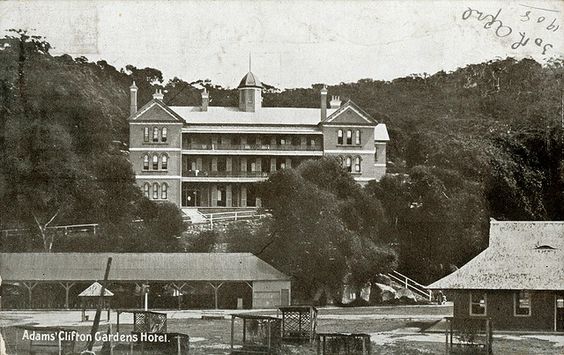--------oOo--------
Clifton Gardens is located in the local government area of the Municipality of Mosman and is part of the Lower North Shore.
Name origin:
Early settler Captain E. H. Cliffe purchased a 23-hectare (56-acre) estate on the waters edge, he named it "Cliffeton" and it is believed that the area's name was derived from that.
About:
Clifton Gardens features an affluent residential area, a big contrast to the earlier mentioned Claymore.
It is home to several beaches and wharves on Sydney Harbour.
Clifton Gardens is also a popular fishing spot.
Clifton Gardens was developed as a picnic spot in the late 1800s, with a local hotelier building a wharf and dance pavilion. In 1909, Sydney Ferries Ltd purchased the estate, and further developed the area, including a large swimming enclosure. The structure burned down in 1956.
Today, Clifton Gardens is touted as ‘remnant bushland’, offering birdwatching, a netted swimming enclosure, change rooms, a fenced playground and spectacular views over Chowder Bay.
There is a walking track from the wharf. It heads towards the playground-end of the beach, then along the beach, passing the playground and rocky outcrop on the left to tend right onto a boardwalk. The boardwalk takes the walk to the lower gate of Chowder Bay. The Bacino Kiosk, just next to Clifton Gardens, is a smaller version of the Bacino Bar above at Chowder Bay. This kiosk supplies passers-by with a home-blend coffee and sandwiches. Continue following the walking track to Georges Heights where you will see a gun emplacement with a commanding 180degree view over the entrance to the harbour. The old gun emplacements are still in position, with their arcs of fire explained in the signs nearby. The view from this lookout is magnificent
Gallery:
Submarine miners depot, wharf
Submarine miners depot, Clifton Gardens
Bacino Kiosk
WW2 gun emplacement, Georges Heights
Clifton Gardens Pool, 1909
Clifton Gardens Pool, 2015
Adams' Clifton Gardens Hotel, 1908\
Built in 1871, the hotel and pleasure gardens were
purchased by Sydney Harbour Ferries Ltd in 1906. The hotel was renamed the Clifton Gardens
Hotel. The beginning of the end for this
sort of entertainment came with the construction of the Harbour Bridge in 1932,
and the consolidation of this area for the doctors, and lawyers, and company
directors of the city. Along with the popularity of the pleasure gardens,
parcels of the original Cliffe Estate were sold off for sububan developments
CLONTARF
Location:
Clontarf is located 13 kilometres north-east of the Sydney central business district in the local government area of Northern Beaches Council, in the Northern Beaches region.
Name origin:
Clontarf gets its name from a coastal suburb of Dublin, known for the Battle of Clontarf in 1014 which freed Ireland from foreign domination. In Irish it means “meadow of the bull”.
About:
Clontarf, Sydney, became infamous as the site of Australia’s first assassination attempt.
On 12 March 1868 Prince Alfred, the Duke of Edinburgh and second son of Queen Victoria, was guest of honour here at a sailor’s picnic. Dublin-born Henry James O’Farrell jumped out of the crowd of picnickers, shooting the Duke in the back. The Duke’s rubber suspenders deflected the bullet, sparing him major injury.
Guilty, O’Farrell was hanged a month later, despite the Duke seeking clemency on his behalf.
In the interim, the Irish O’Farrell was quick to air his anti-British and anti-monarchism views.
Sydneysiders were even quicker to fuel existing anti-Irish sentiment. The NSW Government even passed the Treason Felony Act making it an offence to refuse to drink to the Queen's health.
The Duke and the British monarchy were hugely popular in Australia at this time. When the Duke had arrived by ship three months earlier, nearly ten thousand Sydney-siders came out to welcome him in the pouring rain. This was ten per cent of the city’s 100 thousand population.
After the assassination attempt, citizens donated money for
a “substantial monument in testimony of the heartfelt gratitude of the
community at the recovery of HRH”. Hence the Royal Prince Alfred Hospital in
Sydney was built in 1882.
The sailor’s picnic the Duke attended in 1868 was just another function at what is now Clontarf Reserve.
From the 1860s until closing in 1900, thousands would arrive by ferry from the city for drinking, dancing and games at Clontarf’s dance hall and “pleasure grounds”.
In 1881 The Bulletin newspaper described the behaviour at Clontarf as “not just an excursion – it was an orgy”.
The outraged dance hall operators sued the paper and won. The one-year-old Bulletin couldn’t afford court costs so proprietors John Haynes and Jules Archibald went briefly to jail.
On Archibald’s death years later, he bequeathed funds for
the building of the Archibald Fountain in Hyde Park.
Gallery:
Contemporary sketch from the Sydney Illustrated News of the attempted assassination of Prince Alfred in 1868
Henry James O’Farrell





















No comments:
Post a Comment
Note: Only a member of this blog may post a comment.